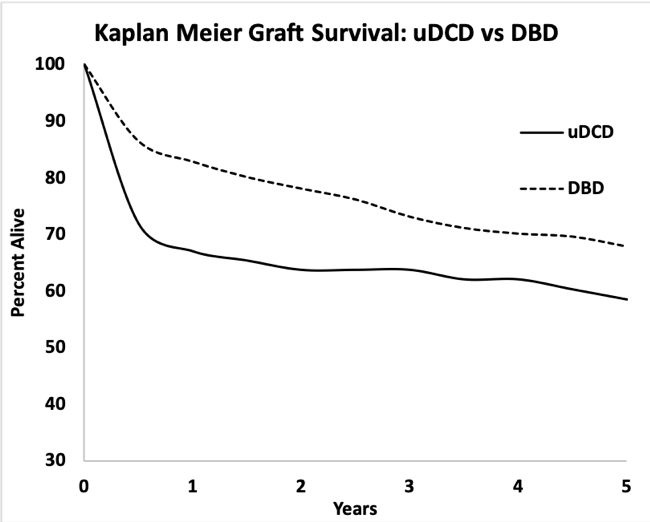Uncontrolled DCD vs DBD Liver Transplantation in the United States: Is it Safe to Push the Envelope?
1Department of Surgery- Division of Transplantation Surgery, University of Colorado Hospital, Aurora, CO, 2Thomas Jefferson University Hospital, Philadelphia, PA
Meeting: 2020 American Transplant Congress
Abstract number: B-121
Keywords: Donors, marginal, Graft survival, Liver grafts, Liver transplantation
Session Information
Session Name: Poster Session B: Liver: MELD, Allocation and Donor Issues (DCD/ECD)
Session Type: Poster Session
Date: Saturday, May 30, 2020
Session Time: 3:15pm-4:00pm
 Presentation Time: 3:30pm-4:00pm
Presentation Time: 3:30pm-4:00pm
Location: Virtual
*Purpose: Uncontrolled donation after cardiac death (uDCD) liver transplantation has been theorized as a potential option to increase the donor pool due to the typical young and healthy profile of donors and also the growing number of trauma/critical care centers with the resources to allow for a uDCD procurement. However, it remains unclear what the long-term graft outcomes following uDCD are in comparison to donation after brain death (DBD) liver transplantation in the United States.
*Methods: All adult uDCD and DBD liver transplants performed between March 2002 and December 2017 in the OPTN/UNOS database were analyzed. Retrospective cohorts included the following patient groups: uDCD, and DBD liver transplant recipients. Kaplan-Meier method was used to analyze graft and patient survival. Cox regression models were utilized to describe adjusted effects of donor/recipient covariates.
*Results: There were 130,283 DBD and 66 uDCD liver transplants performed during the study period. Warm ischemia time was significantly higher following uDCD compared to DBD (16.3 mins vs. 1.1 mins, P<0.01). Additionally, graft survival was inferior at one year (71.9% [uDCD] vs. 86.4% [DBD], P<0.01) and five years post- transplant (58.5% [uDCD] vs. 67.8% [DBD], P<0.01) following uDCD transplantation. Adjusted long-term graft failure remained inferior following uDCD (aHR= 1.85, 95% CI= 1.26 - 2.72, P=0.002).
*Conclusions: Long term allograft outcomes following uDCD liver transplantation are significantly inferior compared to DBD transplantation. Although potential uDCD allografts are often associated with young, healthy donors, factors associated with the procurement process likely reduce the potential utility of these allografts. Further innovations in regard to uDCD procurement such as normothermic regional perfusion are required to reduce the sequelae of warm ischemia, and should be encouraged prior to expansion of uDCD liver transplantation.
To cite this abstract in AMA style:
Choudhury RA, Yoeli D, Yaffe H, Moore HB, Hoeltzel G, Schulick A, Conzen KD, Pomposelli JJ, Pomfret EA, Nydam TL. Uncontrolled DCD vs DBD Liver Transplantation in the United States: Is it Safe to Push the Envelope? [abstract]. Am J Transplant. 2020; 20 (suppl 3). https://atcmeetingabstracts.com/abstract/uncontrolled-dcd-vs-dbd-liver-transplantation-in-the-united-states-is-it-safe-to-push-the-envelope/. Accessed December 29, 2025.« Back to 2020 American Transplant Congress

